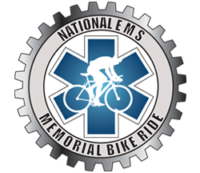Training
We encourage any level riders to participate in any and all portions they are able. Our mission is to honor and celebrate the lives of EMS personnel who have died. You need not be an Olympic cyclist, Ultra level athlete or other fitness guru to complete this event. As with any endurance event, training is key for you to feel your best, fully enjoy the ride and honor our EMS brothers and sisters. After all, we ride in their honor. This is NOT a race!
Be sure to check in with your healthcare provider before beginning any fitness regimen, particularly if you are over 30 years of age, have underlying medical conditions or have not exercised for six or more months. Since, long distance cycling is an aerobic activity, select a training program that will help you improve your cardiovascular fitness, lung capacity and develop your leg strength.
Also worth noting, you’ll need to get your butt in shape as well — literally. One of the most challenging aspects, especially for new riders, is the posterior discomfort you will experience in the early going. The good news is that this can be greatly reduced, or even eliminated, by spending enough time in the saddle BEFORE the ride.
Another benefit of getting plenty of road time is it improves your efficiency on the bike; you’ll be able to save a significant amount of energy just by knowing your bike and what gear you want to be in for a particular stretch of road. Time on the road will allow you to learn how your bike works (shifting, brakes, clip-less pedals, changing a flat tire, seat and handlebar adjustments) and how you are most comfortable riding on it. It is VERY important that every rider have the tools, materials and knowledge to change their own tire during the ride. Nearly every rider experiences a flat during the ride and there is no guarantee that there will be someone available to assist with your tire changes.
While we realize most riders want to ride every mile of the route, and we encourage them to ride every mile they can, please set REALISTIC expectations for yourself. If you do not put in the training before the ride it is unlikely you will be able to keep up the pace the ride must maintain to cover the mileage each day. If you are unable to maintain the pace you will be asked by a Ride Marshal to “sag-out” until the next rest stop. This is for the safety of all riders, including you.
To ensure you are able to ride as many miles as possible during the event please keep in mind the following tips:
- Train… a lot (3 to 4 days a week for several months before the event).
- Ride conservatively at the start of your training and your trip.
- Use all the gears your bike is equipped with and at the appropriate times.
- Be prepared for all kinds of weather (heat, cold, rain, snow and wind).
- Drink plenty of water.
- Eat enough real food. Don’t rely solely on supplements (Energy bars, gels, sport drinks, etc.).
- Know how to do basic maintenance on your bike (change a flat [mandatory], oil your chain).
- Get your bike tuned up before you start the trip.
- Find a training partner to keep you accountable and do long rides together.
- Practice riding at a pace that enables you to maintain a conversation. The NEMSMBR is NOT a race!
Equipment
Required Equipment
- Bike – Yeah, kind of a no-brainer. While any bike will work, we strongly recommend a road bike as it will make your ride much more enjoyable. Use of Mountain Bikes or “Hybrid” bikes prove very difficult on long distance rides. It is recommended that you practice a long ride (40-60 miles) on your bike weeks prior to the start of your Route.
- Helmet – You will NOT be allowed to ride without one!
- Tire levers and patch kit
- 2 extra bike tubes
- Rear safety light – You will NOT be allowed to ride without one!
- 2 water bottles or a hydration system
- Biking footwear
Other Suggested Equipment
- Biking gloves
- Rain jacket (we ride snow, rain or shine)
- Padded bike shorts 2-3 pair
- Long biking pants/tights
- Long sleeve polypropylene or bike shirt
- Bike computer (for mileage, average pace and time)
- Bike tool
- Chain lube with rag
- Tire pump (standard or CO2)
- Sunglasses
- Chamois cream, bag balm, A&D or other soothing gel
All that’s left to do is get on that bike and ride. Best of luck in your training and we’ll see you on the ride!
